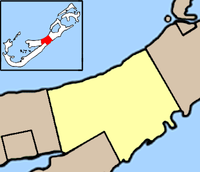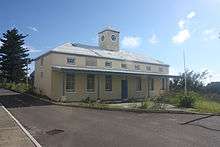Devonshire Parish
Devonshire Parish is one of the nine parishes of Bermuda. Originally named "Cavendish Tribe" and later "Devonshire Tribe. It is named for William Cavendish, 1st Earl of Devonshire (1552–1626). He had never visited Bermuda himself, despite a parish being named after him. Devonshire Redoubt, on Castle Island, one of the Castle Harbour fortifications of St. George's Parish, was also named after him.

Location
It is located in the centre of the territory, close to the junction between the main part of the main island and the peninsula containing the capital, Hamilton, and Pembroke Parish (to which it is joined in the west). To the northeast, it is joined to Smith's Parish, and to the southwest it borders Paget Parish. As with most of Bermuda's parishes, it covers just over 2.3 square miles (6.0 km2). North Shore Road, Middle Road, and South Shore Road all go through this parish.
Natural features
Natural features in Devonshire include Devonshire Bay, and Devonshire Marsh. Devonshire Bay is located on the South shore of Bermuda. There is a national park here and remnants of a fort. Boats moor in the bay for its relatively calm waters. The remnants of the fort was one of the forts from the "fortress Bermuda" project when Bermuda was becoming militarized after the American Revolution. This is the only public beach on the south shore of Devonshire.
Devonshire marsh is in the center of the parish and is on the north side of Middle Road. It was originally known as "brackish pond", which gave the parish its very first name before being officially named. It has been hit by human development over the years; sections were drained for farming and commercial activities. In 1996 there was a significant fire in Devonshire marsh, but the area has recovered since then. There are two nature reserves in the marsh area for its protection - the Firefly and Freer cox nature reserves.
Other, less known natural features include Robinson bay, Orange Valley, Palmetto Park, Garthowen Park, and Friendship Vale Park.
Education
Public schools in Devonshire Parish:
- Devonshire Preschool[1]
- Prospect Preschool[2]
- Elliot Primary School[3]
- Prospect Primary School[4]
- Cedarbridge Academy (senior school)
- Dame Marjorie Bean Hope Academy (special school for multiply-impaired students)[5] - It may hold up to 25 students.[6]
- The Education Center (special school for students with behavioural issues)[7] - It may hold up to 30 students.[6]
Private schools in Devonshire Parish:
- Somersfield Academy[8]
Other features


Other notable features of Devonshire include, or included, Devonshire Marsh, Prospect Camp (including Prospect Fort and Fort Langton - the latter destroyed in the 1980s to make way for a bus garage, and parts of which are now the Bermuda National Stadium, the Ocean View Golf Course, and the Arboretum), Devonshire Dock, the Bermuda Equestrian Centre, the Old Devonshire Church, the Gibbon's Nature reserves, Palm Grove Gardens, and a Museum at the old Elliot School. There are also many old, historical homes throughout the parish that one can see, but most aren't open to the public. Part of the Railway trail goes through northern parts of Devonshire Parish. Are less physical feature in Bermuda.
References
- ↑ Home. Devonshire Preschool. Retrieved on September 14, 2016.
- ↑ Home. Prospect Preschool. Retrieved on September 14, 2016.
- ↑ Home. Elliot Primary School. Retrieved on September 14, 2016.
- ↑ Home. Prospect Primary School. Retrieved on September 14, 2016.
- ↑ Home. Dame Marjorie Bean Hope Academy. Retrieved on September 14, 2016.
- 1 2 "Welcome to Bermuda Schools." Bermuda Ministry of Education. Retrieved on September 14, 2016.
- ↑ Home. The Education Center. Retrieved on September 14, 2016.
- ↑ "Contact." Somersfield Academy. Retrieved on September 14, 2016. "107 Middle Road Devonshire DV 06"
External links
Coordinates: 32°18′00″N 64°45′30″W / 32.30000°N 64.75833°W